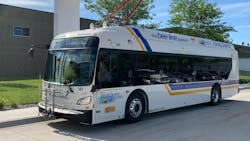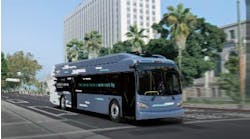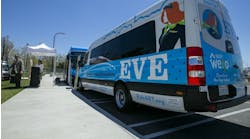The U.S. Department of Energy recently allocated $7 billion in Infrastructure Investment and Jobs Act funding to launch seven regional clean hydrogen hubs. The strategic investment, combined with surging momentum in the battery-electric bus sector, reflects a federal commitment to drive the nation’s journey towards zero-emission solutions.
The U.S. national strategy roadmap aims for net-zero emissions by 2050. While some transit agencies have started the transition, others are contemplating next steps and will need to begin soon. A crucial aspect involves determining the most suitable technology for each entity. The two primary technologies, battery-electric and hydrogen-fuel-cell buses, pose a range of challenges and opportunities for transit agencies deciding between them.
State of play: The current technologies behind zero-emission buses
The most popular and efficient drive of a zero-emission vehicle is an electric motor. Unlike fossil-fueled internal combustion engines, electric motors produce no harmful emissions. To operate an electric motor, energy is stored on the vehicle providing power to run the bus. Two popular technologies for on-board energy storage are currently available in the market, utilizing a battery pack or storing hydrogen and converting it to electricity through a fuel cell on the bus.
Both battery-electric vehicles (BEVs) and fuel-cell-electric vehicles (FCEVs) are available for transit and paratransit buses, trains, trucks, heavy-duty and standard-duty vehicles. For transit agencies to achieve their net-zero targets, selecting the right technology is crucial, with diverse factors influencing the choice, necessitating a tailored transition plan for each agency based on specific conditions.
Charging ahead: A closer look at BEBs
A BEB is equipped with a lithium-ion battery for energy storage, which requires daily recharging. As the vehicle decelerates or runs downhill, a regenerative braking system recharges the battery, turning the motor into a generator and optimizing energy usage. The battery storage capacity, and consequently, the mileage range, is limited by specific physical dimensions and weight, dictated by the maximum allowable axle weight of the vehicle.
BEBs need supporting infrastructure, including charging equipment, electrical power supply and switch gear, cables and conduits, as well as a Charging Management System (CMS). Establishing this infrastructure can entail significant capital expenditure, especially for large fleets requiring the implementation of a new substation. Additionally, utilities need to commit to provide adequate power.
Harnessing hydrogen: A closer look at FCEBs
An FCEB generates electricity through a fuel-cell assembly, bonding hydrogen and oxygen in a chemical reaction. The byproduct is pure water. FCEBs also have a smaller lithium-ion battery that contributes to the propulsion system and is recharged during operations through the same regenerative braking process as in BEBs. Moreover, in operation, if the fuel-cell power exceeds the momentary required power, the surplus energy is redirected to recharge the battery. A bus-mounted energy management system regulates battery charging, ensuring the State of Charge remains within a specified range to guarantee optimal performance and maximize equipment lifespan.
FCEBs require supporting infrastructure including the hydrogen fueling system. The hydrogen may be generated on-site or more commonly delivered to the agency’s depot in liquid form by trucks. Establishing this infrastructure involves components like a cryogenic liquid hydrogen storage tank, pumps, vaporizers, high-pressure storage vessels, a valve panel, master control panel, pump starters, electrical switch gear, piping and hydrogen dispensers. Depending on available spare power, a power upgrade and a new transformer may be needed.
Optimizing energy storage on buses: Balancing the pros and cons
To optimize energy storage on buses, energy modeling is used to determine the amount of energy needed for each route and block, considering on-board energy consumers such as the bus propulsion system, HVAC and auxiliary load. Thorough analysis is crucial for efficient and optimum block planning.
In addition, choosing between BEBs and FCEBs requires consideration of both buses and supporting infrastructure, including duty cycles, costs, safety and feasibility. The table below illustrates main factors to consider, with the pros and cons of each option.
The path to adopting the proper technology
While it’s crucial to consider all the aspects, a single key criterion may significantly influence the decision between the two options in each circumstance, with customization emerging as a key factor. One critical measure is the feasibility of planning blocks and designing infrastructure. For extended routes, where buses cover substantial distances without access to refueling, FCEBs might be the only viable choice, as BEBs are limited by on-board energy storage. In areas with extreme temperatures, FCEBs could also be a better choice.
Conversely, for smaller fleets with limited hydrogen availability during the transition to zero- emissions, BEBs may be a more practical choice. In some cases, a mixed fleet deploying both technologies could be a considerable solution.
Each transit agency possesses unique characteristics that demand a customized transition plan. There is no one-size-fits-all solution; thorough evaluation and analysis are essential to facilitate decision-making within the realm of zero emissions.






